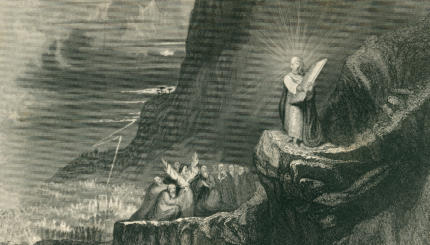This morning my wife and I drove our youngest daughter to the airport as she left for a year of study in Israel to be followed by university study in New York. I think we are now official empty-nesters as our older daughters have established residences of their own. While you never cease being a parent (or a child for that matter), this does usher in a new time in our lives with the usual challenges, but we are both looking forward to this next period.
But what does it mean the nest is empty? We are in constant communication with our children through cell phones and other electronic means. The nest may be physically empty but access to it exists in the digital world. Is there a Jewish lens I can use at this moment to make sense of this experience?
I am going to quote 2 verses and the somewhat long (at least for a blog post) commentary of Rashi. It is worthwhile to study the texts first and only then read my thoughts on them.
1. Genesis 1:2
Now the earth was astonishingly empty, and darkness was on the face of the deep, and the spirit of God was hovering over the face of the water.
and the spirit of God was hovering: The Throne of Glory was suspended in the air and hovered over the face of the water with the breath of the mouth of the Holy One, blessed be He and with His word, like a dove, which hovers over the nest.
2. Deuteronomy 32:11
As an eagle awakens its nest, hovering over its fledglings, it spreads its wings, taking them and carrying them on its pinions.
Rashi
As an eagle awakens its nest: He guided them [Israel] with mercy and compassion like an eagle, which is merciful towards its own fledglings and does not enter its nest suddenly. [Rather,] it beats and flaps its wings above its young between one tree and another, between one branch and another, in order that its young should awaken and have the strength to receive it.
hovering over its fledglings: [The eagle] does not impose its [whole] body upon them. Rather, it hovers above them, touching them and yet not quite touching them. So too, is the Holy One, Blessed is He. [As in the verse:] “We did not find the Almighty great in power” (Job 37:23). When He came to give the Torah to Israel, He did not reveal Himself to them from one direction [thus concentrating His power at one point, as it were], but rather, from four directions, as Scripture states, “The Lord came from Sinai, and shone forth from Seir to them, and appeared from Mount Paran” (Deut. 33:2). [This accounts for three directions.] The fourth direction is referred to in [the verse], “God comes from Teman” (Hab. 3:3). – [Sifrei 32:11]
spreading its wings, taking them: When it [the eagle] comes to move [its fledglings] from place to place, it does not pick them up with its feet, as do other birds. Other birds are afraid of the eagle, which soars very high and flies above them. For this reason, it [the other bird] carries them with its feet because of the eagle [above them]. The eagle, however, is afraid only of an arrow. Therefore, it carries its young on its wings, saying, “It is better that an arrow pierce me, rather than pierce my young.” So too, the Holy One, Blessed is He, [says]: “I carried you on eagles’ wings” (Exod. 19:4). [I.e.,] when the Egyptians pursued [the children of Israel] and overtook them at the [Red] Sea, they cast arrows and catapulted rocks [at Israel]. Immediately, “The angel of God moved… [behind them… and the pillar of cloud] came between the camp of Egypt [and the camp of Israel]” (Exod. 14:19-20) [for Israel’s protection]. — [Mechilta 19:4]
The Hebrew word for hovering, which Rashi sees as associated with the image of a mother bird hovering over her nest, is used twice in the Torah. Rashi appears to have taken the nest image from Deuteronomy and used it in Genesis, although the bird shifts from an eagle in Deuteronomy to a dove in Genesis. God hovers over the world just before creation and God hovers over the Jewish people. Rashi’s image in Deuteronomy of the eagle hovering: “touching them yet not quite touching them”, is a striking description of God’s paradoxical relationship and presence with Israel and the world.
But in the context of Deuteronomy 32, this description only applies in the desert wanderings of the people before they cross over into Israel. Once Israel leaves the nest of the desert, the pillar of cloud will cease and Israel will have to make choices without the guarantee of God’s protection. For the rest of Deuteronomy 32, these will be most unfortunate choices.
The image of the empty nest is then this capacity to choose. We hope and want our children to make the right choices. Yet, I would suggest that according to Rashi we do not have to lose the experience of the nest entirely. It is always recoverable, even if the protective, almost miraculous elements of it are no longer accessible.
The image of the eagle hovering over its young is the image of Sinai. God’s presence in Torah is the moment of “touching them yet not quite touching them”. We can always return to Sinai textually. The miracles of the desert may no longer happen, but the call of Sinai remains. The nest beckons both parents and children to pursue this relationship of “touching them yet not quite touching them” to God and each other.
Torah
Pronunced: TORE-uh, Origin: Hebrew, the Five Books of Moses.


